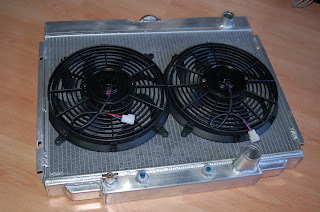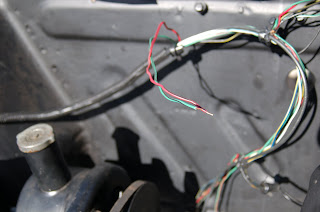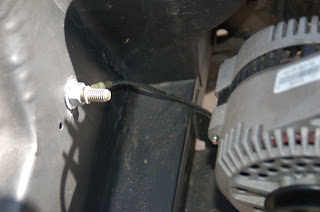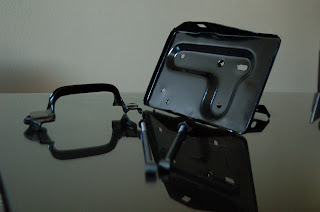Lauren had work today and I wasn't able to play softball tonight (due to the stitches in my chin) even though tonight was the mens league playoffs; the Mustang benefited. With my new radiator in hand, I was excited to get to work installing it. I referred to Mustang Steve's picture of where he recommends that the radiator support be cut although I detoured from it a little. I had an idea to cut the support and then to fold it over 180 degrees in order to use the folded metal as the mounting point for the new radiator.
 |
| 66 Mustang Radiator Support Marked for Modification |
I made a horizontal cut along the top and the bottom of the support and then cut made a vertical cut on each side of the opening while leaving some of the support to fold towards the fenders. There are two vertical marks because I had marked it to leave some extra and then realized that once I folded the flap over on the passenger/battery side would hit the '69 battery tray. I re-marked it about 1 1/8" from Mustang Steve's line. I realized after the fact that I should have cut a larger flap on the driver's side because the radiator doesn't sit in the car symmetrically and I came up short on the bottom mount of the driver's side. The radiator will do fine with three bolts holding it though and doesn't require the fourth.
 |
| '66 Mustang Support Cut to Fit 24" Radiator |
Once the radiator was bolted in, it looked like it was made for the car. It was a tight fit, but that is what made it seem like it was designed for this car.
I actually started the day by looking up the firing order for my 302 and then installing the spark plug wires. The firing order on early (non 80's Mustangs) is 1-5-4-2-6-3-7-8. I laid out the wires in order from longest to shortest to make sure I didn't put a long wire where a short one was needed.
 |
| Early 289 and 302 Firing Order |
The plug wires looked fine even though they weren't black like the ones I ordered. The coil wire would not stay on the coil for some reason so I pushed it through the boot a little further and that seemed to help it stay on the coil.
Once I had the radiator opening cut, painted and the radiator bolted in the car, I was able to cut the radiator hoses to fit. I cut about 4" off the top hose and about 1 1/2" from the lower hose. I also installed the temperature probe for the electric fan relay.
 |
| Thermostat Housing with Extra Water Jacket |
The relay switch for the electric fans is able to be set to turn on between 150-240 degrees using only a screwdriver. I mounted it below the starter solenoid since it is more convenient to have it near the solenoid and the battery with wires needing to go to both areas. The relay also allows for a manual override switch to be installed. Of course I am choosing to run the manual override in case I am driving and the fuse blows while I'm on the freeway or sitting in gridlock traffic. I haven't yet hooked up the switch inside the car, nor do I know exactly where I'm going to put it, but there is a green wire running through the engine loom into the firewall with a piece of masking tape that says "Elec Fan Manual Switch." You can see the green wire below coming off of the relay switch.
 |
| Left: Temp Relay Switch, Right: 3G alternator |
From the front, the radiator looks huge for this year car. If you're used to seeing the 1965-66 Mustangs, then you know how small the radiators usually look. I'll be mounting the hood latch soon which will sit in front of the radiator. The 1969 Mustang/Cougar battery tray that I modified to fit works perfectly with this radiator. The mounting bracket of the radiator almost touches the battery tray.

















































